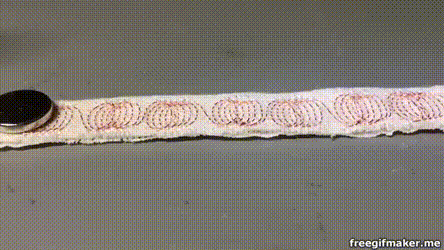We continue experimenting with patterning different types of fibers. When fine insulated wire is embroidered onto a piece of linen tape and supplied with a current, it interacts with magnets. Two sets of embroidered coils, one on top and one on the underside of the tape in this video, pull the tape to the left along an alternating magnet array when the coils are energized in a sequence. Flat embroidered coils near magnets are already used as speakers which can be thought of as a kind of actuator. The above tape is an example of a linear motor that is normally built from hard materials, except in a conventional linear motor, the magnetic part moves, and the coils stay still. Below, a single magnet hops along the coil, keeping to the center where the magnetic field is strongest. Here the coil switching rate is increased from 2 Hz in the tape video, to 5 Hz, and the magnet is able to keep up.


Hi, I tried to build this for my school project, but it was hard to get a fine performance like shown examples of yours. I used thin copper wire and 3mm tiny magnet for this. Apparently, it seems the current or voltage I used causes the malfunctioning. Could you please let me know about the specification of components? Thank you.
Good to know someone out there is building! The wire is 34 gauge and we run about 0.4 Amps through it in this video. Each coil is only about 2 ohms so a quick way to do it is put some 10 ohm, 10 watt power resistors in series with the coil and a 5V driving signal from a motor shield. (A controlled current source would be much more efficient). The two coils are driven 90 degrees out of phase with a square wave at 5 Hz to get motion. The magnet in the video is 10mm diameter but a smaller one might work too.
I love this! As a beginner, though, I don’t quite understand what your power source is–what’s at the end of the blue wire, yellow wire, and clips on the ends of the tape. Is it a battery? What’s the clicking noise?
The clicking noise at the start is a switch that turns on a 5-volt power supply. It’s like a battery, sort of. There are two interleaved coils, so 2 “batteries.” A computer flips each battery’s polarity about 5x per second. There are 4 steps: both batteries forward, battery 1 forward while battery 2 is backward, both batteries backward, and battery 1 backward while battery 2 is forward–then repeat. This sequence keeps pulling the magnet in one direction. If you flip the magnet over, or reverse the sequence, it moves the opposite direction.